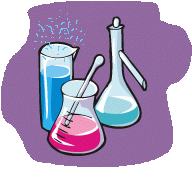


Description of experiment
Below follows a plain text transcript of the selected experiment.
![]()
Needed compounds:
-----------------
sodium metabisulfite : Na2S2O5
sodium fluoride : NaF
sodium hydroxide : NaOH
sodium nitrite : NaNO2
ammonium persulfate : (NH4)2S2O8
hydrogen peroxide : H2O2
hydrochloric acid : HCl
titanium : Ti
Class:
------
elem=Ti,Cl,O,F
coordination
redox
Summary:
--------
Titanium slowly dissolves in concentrated hydrochloric acid, forming deep
blue/violet titanium (III) ions. On addition of hydrogen peroxide these are
oxidized to titanium (IV), which in turn forms a deep red coordination
complex with hydrogen peroxide.
The deep red coordination complex is only stable in acidic to neutral media.
It also is easily reduced by nitrite. It is not affected strongly by
persulfate. With fluoride, a light yellow compound is formed, but the
formation of that may also be due to rise of pH.
Description:
------------
Add some coarsely powdered titanium metal to some concentrated hydrochloric
acid (30% HCl by weight) and heat a little: The metal slowly dissolves. After
a few minutes, the liquid is pale blue/purple. After a few hours, it is blue/
indigo. After two days it is deep blue/indigo. It has a beautiful color.
Dilute the liquid with twice its volume of water: The liquid becomes violet
and remains clear. The color not simply dilutes, it also shifts from blue
purple to a more reddish color component.
Add some hydrogen peroxide (10% H2O2 by weight) to the violet liquid: The
liquid becomes deep red. The blue/purple titanium (III) is oxidized by the
peroxide to colorless titanium (IV) and this forms the deep red coordination
complex with excess hydrogen peroxide.
Dilute with a lot of water: The liquid remains clear and becomes bright red
with a orange tinge.
Take the red liquid as a starting point and add some of this to
1) Some solid NaF;
2) Some solid NaNO2;
3) A solution of NaOH;
4) Some solid Na2S2O5
5) Some solid (NH4)2S2O8
On addition, the following happens:
1) The NaF dissolves and the liquid turns yellow, instead of red.
2) The NaNO2 dissolves and the liquid becomes colorless quickly. There is
slight bubbling of the liquid and a faint brown color can be observed
in the air above the liquid. Apparently, the nitrite (or nitrous acid,
formed in this experiment) quickly reduces the hydrogen peroxide in
the complex and a clear colorless liquid remains. After a while, the
liquid has become somewhat cloudy, probably due to hydrolysis of the
titanium (IV) compound, dissolved in the liquid.
3) The liquid becomes white and turbid. The complex with hydrogen peroxide
apparently cannot exist in alkaline environments and the alkaline
environment causes precipitation of hydrous TiO2 as a white solid.
4) The solid dissolves and the liquid initially remains red. It slowly turns
lighter and after several minutes it has become colorless. The change of
color is much slower than with sodium nitrite.
5) The solid dissolves and the liquid remains red. On heating, the liquid
slowly turns yellow, but it does not become colorless, not even if the
liquid is boiled gently for a minuteand allowed standing for half an
hour.
![]()